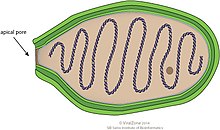| Pandoraviridae | |
|---|---|

| |
| Pandoravirus virion | |
| Virus classification | |
| (unranked): | Virus |
| Realm: | Varidnaviria |
| Kingdom: | Bamfordvirae |
| Phylum: | Nucleocytoviricota |
| Class: | Megaviricetes |
| Order: | Algavirales (?) |
| Family: | Pandoraviridae |
| Genera | |
Pandoraviridae is a proposed family of double-stranded DNA viruses that infect amoebae. There is only one genus in this family: Pandoravirus. Several species in this genus have been described, including Pandoravirus dulcis, Pandoravirus salinus and Pandoravirus yedoma.
History
The viruses were discovered in 2013.
Description
The viruses in this family are the second largest known virus (~1 micrometer) in capsid length, after Pithovirus (1.5 micrometer). Pandoravirus has the largest viral genome known, containing double-stranded DNA of 1.9 to 2.5 megabase pairs.
Evolution
These viruses appear to be related to the phycodnaviruses.
References
- ^ Yong, Ed (18 July 2013). "Giant viruses open Pandora's box". Nature. doi:10.1038/nature.2013.13410. S2CID 88440241.
- ^ Nadège Philippe; Matthieu Legendre; Gabriel Doutre; et al. (July 2013). "Pandoraviruses: Amoeba Viruses with Genomes Up to 2.5 Mb Reaching That of Parasitic Eukaryotes" (PDF). Science. 341 (6143): 281–6. Bibcode:2013Sci...341..281P. doi:10.1126/science.1239181. PMID 23869018. S2CID 16877147.
- Sirucek, Stefan (3 March 2014). "Ancient "Giant Virus" Revived From Siberian Permafrost". National Geographic. Archived from the original on 4 March 2014.
- Brumfiel, Geoff (18 July 2013). "World's Biggest Virus May Have Ancient Roots". National Public Radio. Retrieved 18 July 2013.
- Yutin N, Koonin EV (2013). "Pandoraviruses are highly derived phycodnaviruses". Biol. Direct. 8: 25. doi:10.1186/1745-6150-8-25. PMC 3924356. PMID 24148757.